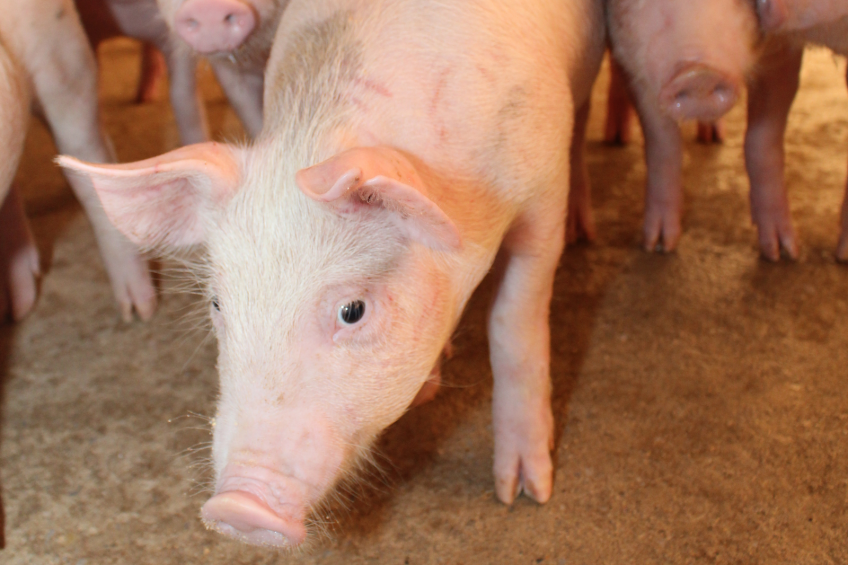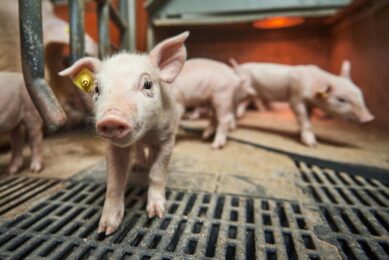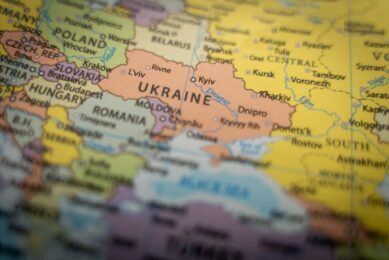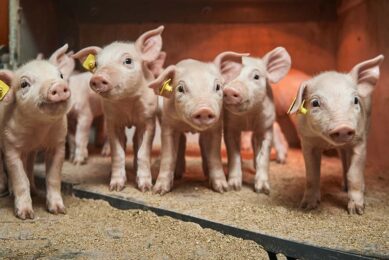Selecting pigs to better meet Asian conditions

Western pig breeds may not always come fully prepared for the Asian reality – full of (different) pathogens and different market needs. A Thai breeding network aims to select genetic lines – resistant to disease and yielding higher lean meat percentages.
In conventional breeding systems, a nucleus herd is free from diseases. Genetics from a high health breeding nucleus will subsequently be distributed to a production herd. Breeders lower in the breeding pyramid of course always try to keep their production herds as free from diseases as a nucleus herd would be – and also try to maintain similar high health standards, e.g. by applying strict biosecurity measures. This is done to enable the pigs to perform to their full genetic potential so that they can deliver effective and competitive products.

Dr Sakchai Topanurak, Chulalongkorn University and driving force behind SiamPigs:
“SiamPigs’ goal is not only to improve production performance, but also to solve endemic and chronic herd health problems.”
Unfortunately, and relatively common in countries in (South East) Asia, the breeding pyramid outside the nucleus farm often fails to provide similar standards. Besides, it is nearly impossible to exclude diseases from a herd. There are 2 major reasons explaining why.
- Pathogens are naturally present all around;
- When parent stock gilts are brought in a production herd for replacement, endemic pathogen inbreeding will increase heterosis – the phenomenon that organisms have enhanced traits as a result of a mix of genetic contributions. When this happens to pathogens, it causes epidemic diseases.
Buying breeding stock
In Asia, some pig producers buy breeding stock from Europe and the US with the expectation that the imported genetics will result in a giant leap forward for their breeding programmes. In doing so, they often make false assumptions when comparing their current performance and projected farm performance. They expect to see a lift in performance, but performance figures are not straightforward phenomena.
Network of pig producers using improved genetics
SiamPigs, established in Thailand, is a network of pig producers using improved genetics, disease tolerant and disease resistant pigs as a tool. The group’s goal is not only to improve production performance, but also to solve endemic and chronic herd health problems. Many pig farms have successfully reduced the risk of infection from outside the farm by applying a model that revolves around the principle of ‘one nucleus, one farm’ – more about this later in the article.
SiamPigs developed its own breeds – Duroc line 929, Large White line 7788, Landrace line 4701 and Siam Kurobuta, with the productivity of the network’s members being on par with the world’s top producers. Farms in the network vary in size, starting from 400 to more than 10,000 sows. The network covers more than 100 farms in Thailand, with over 250,000 sows using breeding stock and semen developed by SiamPigs.
Key to SiamPigs are 3 principles
1. Disease tolerance and resistance
Under real commercial operating conditions, when animals are intensively reared and disease is a limiting factor, natural selection is allowed to do its work. Unlike animals from European or the US genetic farms that have never faced disease challenges, animals selected by SiamPigs are disease tolerant or have resistant traits, and come from its own network across Thailand. Animals that have successfully adapted and continue to be productive are recruited as seed stock for further development and use within the network.
In conventional breeding pyramids, a nucleus herd is largely defined as a disease-free or a high health herd. This, however, does not permit introduction of artificial infections, in order to then select disease-resistant breeding animals. In theory, however, selective breeding for enhanced disease resistance within-breed variation in a real production system, is feasible, based on phenotypic response to disease challenge.
More than 20 farms which have operated over 20 years under conventional breeding systems decided to join the network for breeding development, enervated by repeated devastating outbreaks of epidemic diseases. Pigs in the SiamPigs network are resistant to Porcine Reproductive and Respiratory Syndrome (PRRS), Actinobacillus pleuropneumoniae (App) and E. coli. Currently the network is also doing QTL analysis research to study resistance against other diseases.
Figure 1- Selection disease tolerance/resistance in practice.

The network can select disease tolerant or resistant animals that even experienced diseases but can nevertheless provide a good productivity to be used in breeding schemes (Figure 1). The experience in Thailand is that progeny from imported breeding stock appeared more susceptible to disease than progeny of SiamPigs.
As a result, the network’s pigs need fewer drugs or antibiotics, leading to less residue in pork, hence an enhanced food safety.
2. One nucleus, one farm (ON-OF) model
This, aforementioned model, uses disease resistant pigs in combination with a closed herd system, reducing the risk of problems. The ON-OF model is a closed herd designed to replace great grandparent (GGP) breeding stock by all SiamPigs breeds (Figure 2).
Figure 2- ON-MF model and ON-OF model.

A conventional breeding system could be called a ‘one nucleus, multiple farms’ model (ON-MF), where breeding stock is imported for replacement. In this model, despite many strategic management advantages, like within-herd gilt multiplication, good biosecurity measures and proper vaccination, disease outbreaks are still likely. Often it is believed that quarantine reduces the risk of disease introduction with newly imported breeding stock. Nevertheless, quarantine could also be seen as a strategic mistake which can result in increasing the potential of pathogens to reach recombination or heterosis beyond the levels that vaccination could cover (Figure 4).
Figure 3 – The theory behind the GGR breeding model.

Especially when a nucleus herd continuously distributes parent stock gilts to multiplication herds and then executes quarantine measures before transferring breeding stock or parent stock gilts into the farm, such quarantine allows endemic pathogens to enhance their heterosis and thus the epidemic diseases to occur.
Figure 4 – Heterosis effect of pathogens.

Based on production efficiency, the ON-OF model yields an optimum performance with consistent results. This is the result of genetic selection using BLUPbase software which has been tried out in different environments in the field.
It is apparent that differences in production efficiency are generally the result of disease. The more animals that are brought into the farm, the greater the contagious risk becomes, especially if the animals are brought in from various sources. The ON-OF model minimises the frequency and number of animals brought into the farm. Selection is based on environment, nutrition, housing and management. Due to this resulting heavy focus on uniformity, the overall performance of farms within the SiamPigs network is consistent and competitive.
3. High lean sire and dam lines (GGR model)
To create a lean meat focus in both the sire as well as the dam breeding line.
Breeding objectives in Europe and the US are often to focus on their market needs, i.e. to the culture of red meat and fat consumption. For example, the industrial sausage manufacturing requires lots of fat mixture rather than lean meat only. This usually happens in combination with selective breeding, focusing on achieving a high number of piglets per sow per year (PSY). The negative genetic correlation between PSY and lean meat percentage makes the end product (the pigs) suboptimal for the needs of countries importing breeding stock, e.g. those of Thailand. Often, illegally salbutamol is used in several Asian countries in an attempt to ‘correct’ this, as meat with a higher lean meat percentage is what is desired.
Besides, the selection of terminal sires is usually not enough to effectively drive the parent stock to produce finishing pigs containing as much red meat, meeting market satisfaction. Therefore, in order to solve this problem the selective breeding of the dam line is to be targeted at ‘high lean sow’, which SiamPigs also has defined as selective breeding goal from the beginning. The pig production system yielding a higher red meat percentage, corresponding to Thai market needs is called the ‘GGR model’, in which ‘G’ refers to growth and and ‘R’ to reproduction.
Major problems
In short, pig breeds have not always been developed to be resistant to endemic pathogens – in the case of SiamPigs, those in Asia. For that reason, this network chose to focus on the selection of disease tolerant or resistant pigs and create its own network of disease prevention. The ON-OF model not only prevents infection introduced with imported breeding stock and replacement gilts but also makes disease pressure in the herd cool down. As a result, not only nucleus farms will have a high health, but all farms will. In addition, since the production that meets the market needs in each country on each continent are different, the swine selection goal of each country is to be determined differently and appropriately to each region’s market needs as well.
References available on request.
How the SiamPigs strategy works on a farm in Thailand can be read in one of the upcoming editions of Pig Progress.
Join 18,000+ subscribers
Subscribe to our newsletter to stay updated about all the need-to-know content in the pigsector, three times a week. Beheer
Beheer










 WP Admin
WP Admin  Bewerk bericht
Bewerk bericht